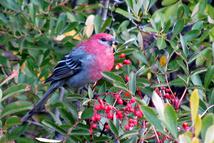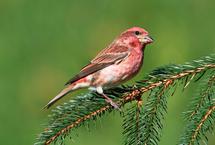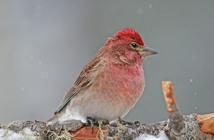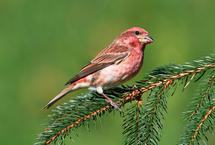saveourplanetearth.com
Call us: (775) 831-1331
Finches
It isn’t often I spot a new bird, considering I walk the same route in the same area every day, but a little over a month ago I started hearing a new song. It took some time and a little bit of luck but I was able to identify the song as coming from a Cassin’s finch.
The day I saw him, he was singing a duet with a fox sparrow. I could see them both, but did not have my binoculars with me so I had to identify him using his song and call notes.
The Cassin’s finch song is similar to that of the house finch, as well as the purple finch. They also look very much alike, so identifying them can be tricky. According to my many bird maps, we are unlikely to see a purple finch in our area.
These three finches are similar in size and shape and coloring. They all have raspberry-colored heads, and, in the case of the house and purple finches, the raspberry continues down its back and chest. The Cassin’s finch has a tufted head and more of a pinkish or buff-colored chest, with a whitish thin ring around his eye.
The house finch has a short, stubby bill that is slightly hooked and a smooth head. The wings of all the birds are brownish and greyish, tipped with lighter colors. It is truly a challenging identification so be sure to listen for the song and the call notes.
The songs of these three birds are similar but the call notes are different, and it was the call note of the Cassin’s that enabled me to identify him, but it was his song that led me to finches.
I know the songs and calls of maybe a couple of dozen birds but I always know when I hear something different. That’s when I break out my small digital recorder and attempt to capture the sound.
When identifying a bird in the field, gather as many clues as you can: Relative size, coloring, look for bands of color across the eyes or wings, size and shape of the beak, length and shape of the tail. Listen to the song and the call notes, record the sounds and list any physical characteristics you have observed. If you don’t have a recorder, smart phones have recording capabilities.
A very handy tool to use on your smart phone is the free Merlin Bird ID App, which you can access and download from allaboutbirds.org, a site offered by the Cornell Lab of Ornithology. This site is so valuable to me in my pursuit of bird knowledge that I like to make use of the “Donation” tab from time to time, to support their efforts and to show my appreciation.
The app takes you through a short questionnaire to help you describe the bird you are seeing. It calculates your position and offers suggestions on birds that might appear in your area with those characteristics. You can even listen to the sounds of the bird, which, for me, is often the final piece of the puzzle that assures me I have the correct identification.
Finches are passerine birds in the family Fringillidae. A “passerine” is any bird of the order Passeriformes, which includes more than half of all bird species.
A distinguishing characteristic of the Passerines is the arrangement of the toes: Three toes point forward and one backward. Some examples of non-Passerine birds for comparison are quail; shore birds such as gulls, terns, avocets and snipes; also parakeets and parrots.
Finches eat mainly seeds, which attracts them to backyard bird feeders. Other members of the finch family that might visit your feeders are the pine siskin, evening grosbeak and black-headed grosbeak. Pine siskins are seeking the thistle, while the grosbeaks prefer to dine on the sunflower seeds.
A pretty pink finch you most likely won’t see at bird feeders is the pine grosbeak. Find this bird in the coniferous forest seeking small fruits. One of the largest of the finches, the pine grosbeak measures 8 to 10 inches, has a plumb breast and a thick stubby bill. He’s rose-colored, with black wing accents and tail feathers.
I’ve never seen one, but Franny Bryan, hiking on Mount Tallac with her husband, Chris, managed to capture a picture of this one sitting nearby in a bush, dining on some berries.
If you keep your eyes and ears open when out in nature, you might be surprised at the treasures you’ll turn up.
Male Cassin's finch
canstockphoto.com
Male purple finch
canstockphoto.com
House finch
canstockphoto.com
Pine grosbeak
Franny Bryan






